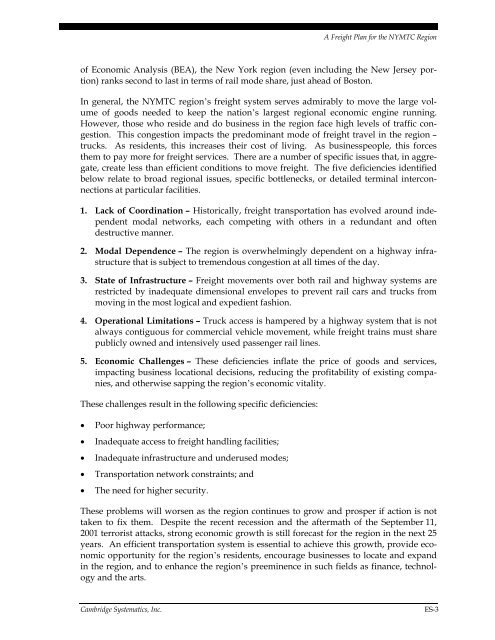nymtc regional freight plan - New York Metropolitan Transportation ...
nymtc regional freight plan - New York Metropolitan Transportation ...
nymtc regional freight plan - New York Metropolitan Transportation ...
Create successful ePaper yourself
Turn your PDF publications into a flip-book with our unique Google optimized e-Paper software.
A Freight Plan for the NYMTC Region<br />
of Economic Analysis (BEA), the <strong>New</strong> <strong>York</strong> region (even including the <strong>New</strong> Jersey portion)<br />
ranks second to last in terms of rail mode share, just ahead of Boston.<br />
In general, the NYMTC region’s <strong>freight</strong> system serves admirably to move the large volume<br />
of goods needed to keep the nation’s largest <strong>regional</strong> economic engine running.<br />
However, those who reside and do business in the region face high levels of traffic congestion.<br />
This congestion impacts the predominant mode of <strong>freight</strong> travel in the region –<br />
trucks. As residents, this increases their cost of living. As businesspeople, this forces<br />
them to pay more for <strong>freight</strong> services. There are a number of specific issues that, in aggregate,<br />
create less than efficient conditions to move <strong>freight</strong>. The five deficiencies identified<br />
below relate to broad <strong>regional</strong> issues, specific bottlenecks, or detailed terminal interconnections<br />
at particular facilities.<br />
1. Lack of Coordination – Historically, <strong>freight</strong> transportation has evolved around independent<br />
modal networks, each competing with others in a redundant and often<br />
destructive manner.<br />
2. Modal Dependence – The region is overwhelmingly dependent on a highway infrastructure<br />
that is subject to tremendous congestion at all times of the day.<br />
3. State of Infrastructure – Freight movements over both rail and highway systems are<br />
restricted by inadequate dimensional envelopes to prevent rail cars and trucks from<br />
moving in the most logical and expedient fashion.<br />
4. Operational Limitations – Truck access is hampered by a highway system that is not<br />
always contiguous for commercial vehicle movement, while <strong>freight</strong> trains must share<br />
publicly owned and intensively used passenger rail lines.<br />
5. Economic Challenges – These deficiencies inflate the price of goods and services,<br />
impacting business locational decisions, reducing the profitability of existing companies,<br />
and otherwise sapping the region’s economic vitality.<br />
These challenges result in the following specific deficiencies:<br />
• Poor highway performance;<br />
• Inadequate access to <strong>freight</strong> handling facilities;<br />
• Inadequate infrastructure and underused modes;<br />
• <strong>Transportation</strong> network constraints; and<br />
• The need for higher security.<br />
These problems will worsen as the region continues to grow and prosper if action is not<br />
taken to fix them. Despite the recent recession and the aftermath of the September 11,<br />
2001 terrorist attacks, strong economic growth is still forecast for the region in the next 25<br />
years. An efficient transportation system is essential to achieve this growth, provide economic<br />
opportunity for the region’s residents, encourage businesses to locate and expand<br />
in the region, and to enhance the region’s preeminence in such fields as finance, technology<br />
and the arts.<br />
Cambridge Systematics, Inc.<br />
ES-3
















